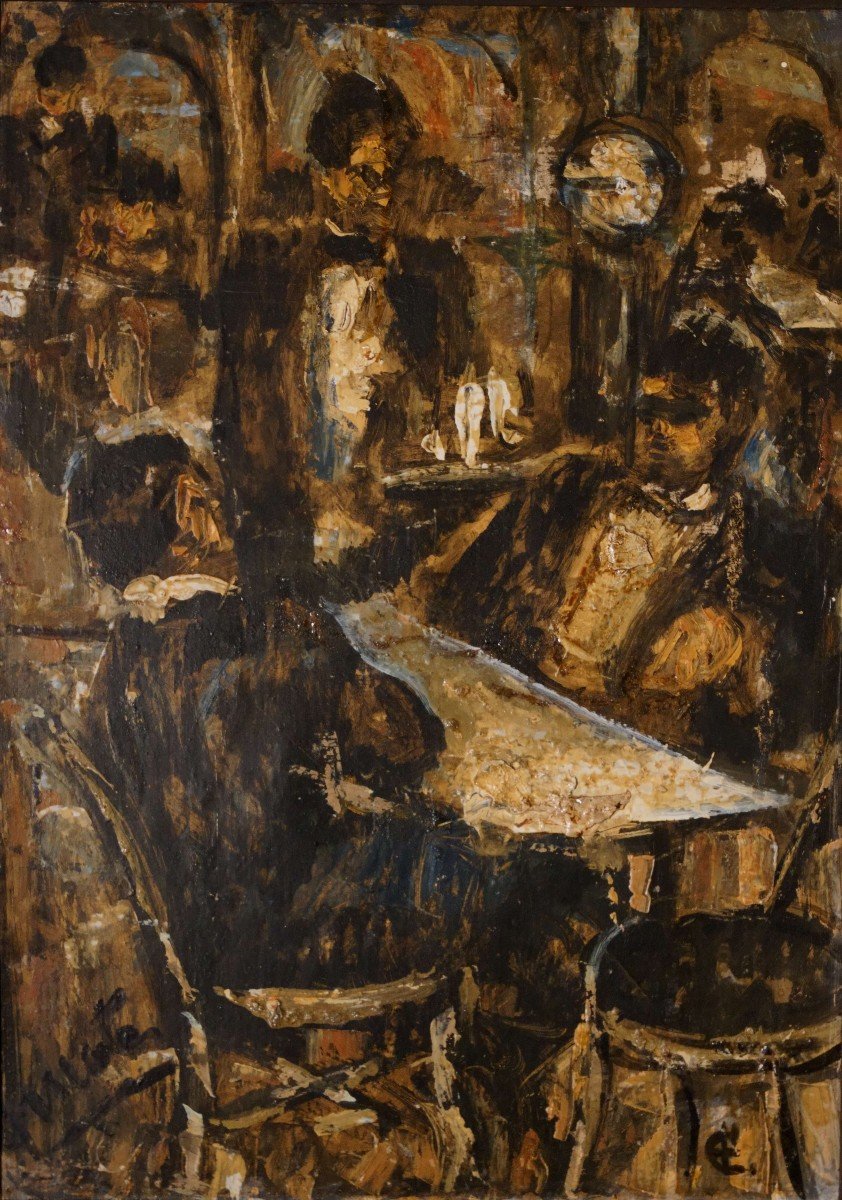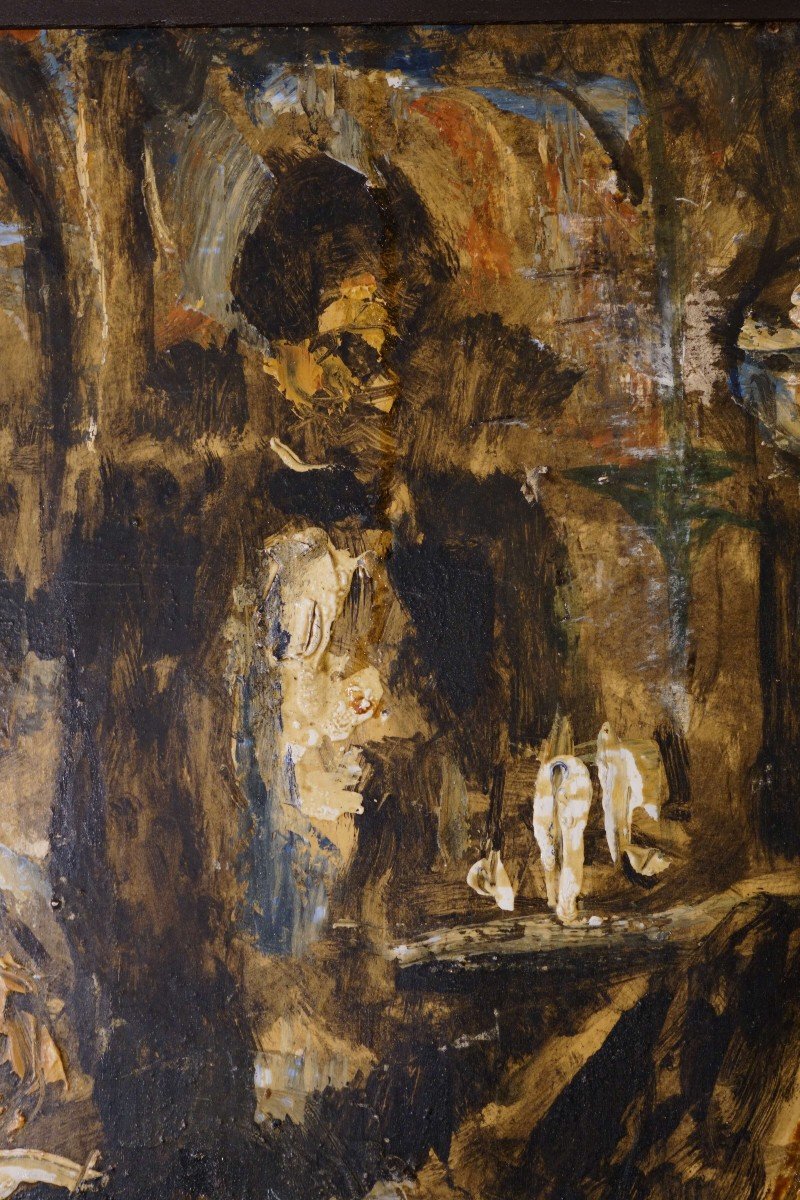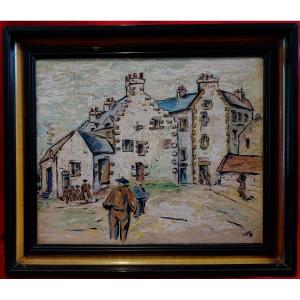Measurements
panel cm 53 x 38
Antonio Fuentes was born on October 9, 1905, at the Fuentes Hotel in Tangier, in the same hotel where Camille Saint-Saëns composed the "Danse Macabre". In the same small souk that Delacroix, Fortuny, Tapiró, Van Rysselberghe, Iturrino, Matisse painted...
As a child, Antonio Fuentes painted on the marble tables of the Fuentes café.
At thirteen, he made drawings for "l'Héraut du Maroc". At fourteen, illustrations for "la Sphère" and "Le Nouveau Monde". Without knowing it, he became the Toulouse-Lautrec of Tangier, as Pierre Gassier, a great French Hispanist, would call him years later. Encouraged by the Spanish artists Abascal and Ortiz Echagüe, he decided to devote himself to painting. He drew the world around him and painted it, distorting it in an ironic way.
Having just finished his military service in Cadiz in 1925, Fuentes went to study in Madrid, where he entered the Royal Academy of Fine Arts of San Fernando. From this period dates a very beautiful portrait of Federico García-Lorca, now deceased, but which we can see in some of the photos of Fuentes in his studio.
The academicism of Madrid did not suit him and he decided to go to Paris, to the Montparnasse of the time. In 1929, he painted all day at La Grande Chaumière, a huge and dislocated academy-studio where all the great names of contemporary painting had passed through. Fuentes drew with a brush and thus obtained enormous strength and security in his sketches. He became a very great draughtsman.
In Paris, he made caricatures for “La Semaine de Paris”. Thanks to these caricatures, he met all the Spanish personalities who went to Paris: Manuel de Falla, Encarnación López – “La Argentinita”, Vicente Escudero, Andrés Segovia. His series of “bailaores” of the Spanish ballets dates from this period.
In the evening, he met in cafés with the other Spanish painters: Souto, Pelayos, Bores. However, as Emilio Sanz de Soto quotes, "Fuentes was so absorbed in the spirit of the small souk of Tangier, of the daily cohabitation with Arabs and Jews, that the painters with whom he had become friends were the two Jews Moïse Kisling and Chaïm Soutine." He did not share the artistic opinion of most of his compatriots since "they were all obsessed with Picasso - which was natural - but what was for Picasso only a simple divinatory instinct, my compatriots converted into mental algebra." In 1934 he left for Italy to continue his training. First in Florence, as a disciple of Felice Carena (1879-1965), then in Rome, where he entered the Academia Española de Bellas Artes. His admission signed by Valle-Inclán, director of the Academia, has also been preserved. He continued to collaborate with the Spanish press by sending his illustrations from Italy.
At the end of the Second World War, Fuentes returned to Tangier and locked himself in his house-studio in the medina, on the Place des Aïssaouas. From that moment on, he would exhibit only rarely: only when great friends or institutions managed to convince him. On these occasions, the great names of artistic and cultural criticism recognized his exhibitions.
From 1973, Antonio Fuentes isolated himself completely on a social and artistic level. He spent all his time in meditation and his work focused on abstraction, arriving at the series of frottages of 1990. Fuentes was already 85 years old. He enjoyed the freedom of being able to devote himself exclusively to his work, without anything distracting him from it and without having to "commercialize" it. He sells in his studio when "the buyer has enough desire to own my work." Buyers had to venture out to see if Fuentes would receive them, and if he did, to see if they could buy works from him. In the nineties, the Consulate General of Spain in Tangier offered him to hold a retrospective exhibition of his work. Fuentes refused. Later, they offered to convert his house into the Fuentes Museum, and to hold a Traveling Anthological Exhibition, accompanied by a general catalogue of his work, including a photographic catalogue made up of more than 450 works distributed in important private collections around the world, from South America to the United States and from Europe to Saudi Arabia. Fuentes refused both proposals. During the last years of his life, he spent his time revealing, in an almost systematic writing, all his memories. Fuentes tells us how he met Picasso in the art supply store next to the Castelucho gallery, and the subsequent visit with the Master of the gallery exhibition. During this visit, Antonio Fuentes suggested to Picasso, so as not to create interference between them, that each of them go through the exhibition in opposite directions and at the exit, to comment on which piece was the best. They both agreed on their appreciation: “A Gypsy” by Nonell. During this meeting with Picasso, Fuentes also tells us how the owner of the gallery, who had one of his works in reserve, offered him a large sum for a painting that she wanted to buy from him. Fuentes had doubts about this sale. Picasso advised him not to hesitate, that he sell it in such a way as to build up a clientele in Paris. In this series of texts, Fuentes describes Picasso as an elderly man – Antonio was twenty-five at that time and Picasso fifty – with a bourgeois appearance, wearing a good English overcoat and a Borsalino hat and whom he considered his father given his humble attitude. Antonio Fuentes died in Tangier on July 25, 1995, without ever having stopped working. Even during the last days of his life, he did not like to be distracted. He only agreed to abandon his house-studio in the medina of Tangier one day before his death, which finally occurred at the Spanish Hospital in Tangier.












































 Le Magazine de PROANTIC
Le Magazine de PROANTIC TRÉSORS Magazine
TRÉSORS Magazine Rivista Artiquariato
Rivista Artiquariato